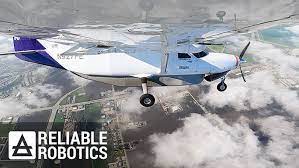Reliable Robotics Reveals Airspace Integration Solution; Marc Pos to Lead Critical Radar Systems Component
Reliable Robotics announced the addition of Marc Pos to lead radar design, filling a key part of its aircraft-agnostic Airspace Integration Solution plans. Reliable Robotics is developing a solution to enable the safe, secure, and efficient integration of remotely piloted aircraft – crewed or uncrewed – in the National Airspace System (NAS). As Senior Fellow, Pos will focus on the industry-wide challenge of certifying Detect and Avoid (DAA) systems capable of detecting and tracking all airspace users, regardless of whether or not they are equipped with a transponder. Radar is the only all-weather, non-cooperative sensor for DAA, and no existing airborne radar currently enables commercial aircraft considering size, weight, power, and cost drivers.
“We’ve been strategically focused on certifying our safety-enhancing aircraft automation system and simultaneously building an Airspace Integration Solution that allows remotely piloted aircraft to be safely integrated into our airspace. With Marc’s expertise, we will advance our DAA capabilities using novel radars, which is core to the solution,” said Brandon Suarez, VP of Uncrewed Aircraft Systems (UAS) Integration at Reliable Robotics.
Reliable’s Airspace Integration Solution
Integrating UAS into the NAS requires a comprehensive set of interdependent subsystems, specifically, DAA systems, C2 links, and the control station. These subsystems, functions, and capabilities are collectively part of an end-to-end, certifiable solution for new and existing aircraft to be remotely piloted.
Pos will join Suarez to drive the development and certification of Reliable’s Airspace Integration Solution. Pos has nearly 30 years of experience designing radios, radars and radar altimeters. During his 21-year tenure at Honeywell, he most recently served as a Radar System Fellow. He has led cross-disciplinary teams that developed phased array radar systems for airborne DAA, ground-based obstacle avoidance and navigation, as well as all-weather radars and radar altimeters used for autolanding in transport category aircraft today such as the Boeing 737 and the Airbus A320.
Pos led a published NASA study on the usability of the radar in the NAS, a project aimed at enabling beyond-visual line of sight (BVLOS) operations. Pos holds 14 patents for radar and radar altimeter innovations. He has also served on multiple RTCA committees related to radar sensing in DAA systems and currently participates in SC-228.
“Developing a reliable DAA solution that can be certified for operations in the NAS will be a win for the industry,” said Marc Pos, Senior Fellow at Reliable Robotics. “I’m looking forward to growing the radar division and expanding the capabilities of Reliable’s Airspace Integration Solution.“
Importance of Radio Detection And Ranging (RADAR) Capabilities
A certified radar can be used on aircraft with or without a pilot on board to enhance operational safety, especially as commercial operations expand to more airports outside of metropolitan areas, which is the vision of Regional Air Mobility. Radars can detect objects in all weather conditions by measuring distance using radio waves (R.F.). Radars provide an object’s range, speed, and if it is coming or going all in one detection. The FAA has published TSO-c212, which recognizes radar as a viable solution for air traffic detection and tracking, specifically invoking RTCA DO-366 as a valid performance standard. Adding radar to the Reliable Robotics sensor suite will provide a robust and certifiable DAA solution.

